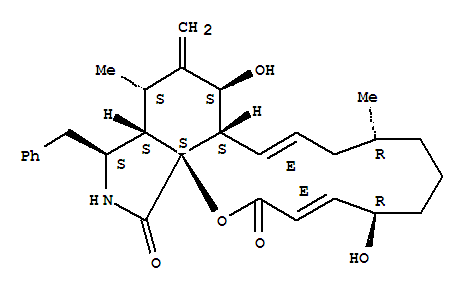2H-Oxacyclotetradecino[2,3-d]isoindole-2,18(5H)-dione,6,7,8,9,10,12a,13,14,15,15a,16,17-dodecahydro-5,13-dihydroxy-9,15-dimethyl-14-methylene-16-(phenylmethyl)-,(3E,5R,9R,11E,12aS,13S,15S,15aS,16S,18aS)- cas no:14930-96-2
Synonyms: 24-Oxa[14]cytochalasa-6(12),13,21-triene-1,23-dione,7,20-dihydroxy-16-methyl-10-phenyl-, (7S,13E,16R,20R,21E)-;2H-Oxacyclotetradecino[2,3-d]isoindole-2,18(5H)-dione,16-benzyl-6,7,8,9,10,12a,13,14,15,15a,16,17-dodecahydro-5,13-dihydroxy-9,15-dimethyl-14-methylene-,(E,E)-(5R,9R,12aS,13S,15S,15aS,16S,18aS)- (8CI);2H-Oxacyclotetradecino[2,3-d]isoindole-2,18(5H)-dione,6,7,8,9,10,12a,13,14,15,15a,16,17-dodecahydro-5,13-dihydroxy-9,15-dimethyl-14-methylene-16-(phenylmethyl)-,[5R-(3E,5R*,9R*,11E,12aS*,13S*,15S*,15aS*,16S*,18aS*)]-;Cytochalasin B;NSC107658;Phomin;
Name2H-Oxacyclotetradecino[2,3-d]isoindole-2,18(5H)-dione,6,7,8,9,10,12a,13,14,15,15a,16,17-dodecahydro-5,13-dihydroxy-9,15-dimethyl-14-methylene-16-(phenylmethyl)-,(3E,5R,9R,11E,12aS,13S,15S,15aS,16S,18aS)-
CAS14930-96-2
Synonyms24-Oxa[14]cytochalasa-6(12),13,21-triene-1,23-dione,7,20-dihydroxy-16-methyl-10-phenyl-, (7S,13E,16R,20R,21E)-;2H-Oxacyclotetradecino[2,3-d]isoindole-2,18(5H)-dione,16-benzyl-6,7,8,9,10,12a,13,14,15,15a,16,17-dodecahydro-5,13-dihydroxy-9,15-dimethyl-14-methylene-,(E,E)-(5R,9R,12aS,13S,15S,15aS,16S,18aS)- (8CI);2H-Oxacyclotetradecino[2,3-d]isoindole-2,18(5H)-dione,6,7,8,9,10,12a,13,14,15,15a,16,17-dodecahydro-5,13-dihydroxy-9,15-dimethyl-14-methylene-16-(phenylmethyl)-,[5R-(3E,5R*,9R*,11E,12aS*,13S*,15S*,15aS*,16S*,18aS*)]-;Cytochalasin B;NSC107658;Phomin;
EINECS(EC#)239-000-2
Molecular FormulaC29H37 N O5
Molecular Weight479.60778
Appearancepowder
refractive index1.596
storage temp−20°C
Globally Harmonized System of Classification adn Labelling of Chemicals(GHS)
Hazardclass6.1(a)
Hazard T+: Very toxic;
Risk R26/27/28;R63
Safety
Poison by intraperitoneal route. An experimental teratogen. Human mutation data reported. When heated to decomposition it emits toxic fumes of NOx.
Hazard Codes:
T+: Very toxic .gif)
T: Toxic .gif)
Risk Statements about Cytochalasin B (CAS No.:14930-96-2):
R63 Possible risk of harm to the unborn child.
R23/24/25: Toxic by inhalation, in contact with skin and if swallowed.
R26/27/28: Very toxic by inhalation, in contact with skin and if swallowed.
Safety Statements about Cytochalasin B (CAS No.:14930-96-2):
S28 After contact with skin, wash immediately with plenty of soap-suds.
S45 In case of accident or if you feel unwell, seek medical advice immediately (show the label whenever possible.)
S36/37: Wear suitable protective clothing and gloves.
| 1. |
|
dni-hmn:oth 1 mg/L
|
|
CNREA8 Cancer Research. 45 (1985),311. |
| 2. |
|
dni-hmn:hla 1 µmol/L
|
|
MUREAV Mutation Research. 92 (1982),427. |
| 3. |
|
cyt-hmn:fbr 1 mg/L
|
|
JCLBA3 Journal of Cell Biology. 89 (1981),194. |
| 4. |
|
cyt-hmn:oth 1 mg/L
|
|
JNCIAM Journal of the National Cancer Institute. 52 (1974),653. |
| 5. |
|
cyt-mus:mmr 1 mg/L
|
|
ITCSAF In Vitro. 19 (1983),58. |
| 6. |
|
ipr-ham TDLo:5 mg/kg (female 8D post):TER
|
|
TJADAB Teratology, A Journal of Abnormal Development. 22 (1980),59. |
| 7. |
|
ipr-rat LD50:11 mg/kg
|
|
TOXIA6 Toxicon. 17 (1979),137. |
| 8. |
|
ipr-mus LD50:30 mg/kg
|
|
FEPRA7 Federation Proceedings, Federation of American Societies for Experimental Biology. 38 (1979),438. |

